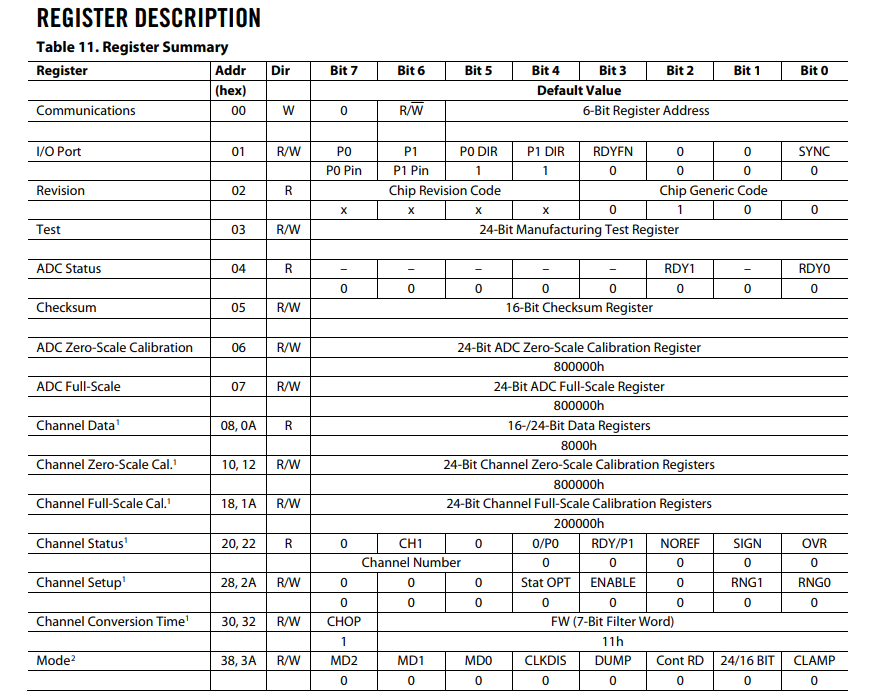 |
CROSS Technical Documentation User Manual and Technical Doc.
INFN Milano Bicocca
|
 |
CROSS Technical Documentation User Manual and Technical Doc.
INFN Milano Bicocca
|
SUMMARY:
The ADC on board is the 24 bits AD7732BRU datasheet. It has some parameters that can be set with flags in its instruction. Its main function to be called is ADC_lettura(), whose code is the following:
Reading result has to be multiplied by numeratore, then divided by denominatore. This to work with integer numbers: remember that our voltages are in µV.
Each node to be read has its own identity; as an instance, the detector bias is read after a voltage attenuator. The reading nodes are organized in groups of 6, there is a vector structure whose locations are retreived by node_number/6:
Here is the vector ADC_coefficiente and here we see the coefficient values:
These number are exploited by the function ADC_compensazione_al_nodo() that needs as input parameters the node that is being measured by line_to_read. Then, from the ADc measured value, lettura_ADC and offset lettura_offset the actual node voltage is obtained. The above coefficiennts take into account the attanuator factors at the buffer inputs according to the following figure:

At startup, within instr_inizializza_tutto_da_zero_function(), both ADC's are initialized. The first action done on ADC is the settings of its configuration pins. This is done at startup by the function ADC_pin_configurations(void). Soon after that the SPI protool is set, SPI_Inizialize(), the ADC's zero scale calibration is done, with ADC_selfcal_zero_scale(uint8_t up_down) invoked 2 times, one for each ADC present, than, the ADC's are sent into powerdown state with the function ADC_Sleep_fun(uint8_t up_down), invoked 2 times, too.
The ADC functions list is here:
On the top of the above list there are the 2 functions that operate globally the ADC's to perform the measurement.
The first one is ADC_misura_differenziale_con_media_generico() that allows to set all the necessary parameters to perform the measurement. The user could use only this function to operate the ADC.
There are 2 parameters that are not passed to the function but are global and need to be set at least once, or their default values are considered.
The variable ADC_medie_per_misura is the first of the 2 variables that are not passed as a parameter but is a global. It can be set with the instruction via CAN, instr_ADC_LETTURA. It says to the function how many measurements of the node must be taken and averaged.
The other variable that is not passed, but is global is ADC_non_leggi_lo_offset_se_true. If it is true the input offset of the buffer which stands in front of the ADC is not read, Figure_ADC_Buffer_attenuation_input. With the new OA used the offset is very small and its measurement can be omitted. This shortens the reading time. This flag can be set ON or OFF from the instruction, instr_ADC_LETTURA.
The input parameters to the first function are:
The second function, ADC_misura_differenziale_single_ended(), is invoked from the previous function. Its parameters are similar to the previous described above:
The function ADC_pin_configurations() is invoked just one time, at the startup. Calibration is done at startup, too, and can be invoked from time to time from the CAN, too.
ADC_Wakeup() is called every time a reading must be taken, while ADC_Sleep_fun() is invoked at the end of the reading function.
ADC_lettura_24bit(char ADC_0_o_1 , uint8_t up_down, uint8_t cosa_fare) allows a single reading of the previously selected node. It needs to know which of the 2 ADC channels to use with ADC_0_o_1, and which ADC to consider with up_down. The last parameter cosa_fare allows to operate the 2 ADC in parallel, if needed. It cover 3 values as it follows:
An example of parallel operation is here (cosa_fare=1 combined with cosa_fare=3):
An example of non parallel operation is here (cosa_fare=2):
The inputs of the ADCs are buffered. The input resistor of the buffer is a switchable, in principle. This feature cannot be used since the switches are MOS whos parasitic diode becomes forward bias when the input voltage goes negative. In this versione of the board the MOS are used for another fnctions and the resistirs is held to GND. Its value is not 10 KΩ, as in the picture below, but 82 KΩ; at the same time the resistor in series to the analog MUX's ouputs is now 8.2 KΩ. This combination attenuates a little the value of the input node to measure and avoid to be too close to the rails, where the accuracy of the buffer lowers a little.

ADC_lettura_registro() allows to read a whatever ADC internal register of the selected ADC and ADC channel. Possible choices are (select the left number of the Addr column):

ADC_lettura(uint8_t scheda_su_scheda_giu, uint8_t node_to_read, uint8_t cosa_fare) sets the path, from the node to read, to the ADC input. First of all scheda_su_scheda_giu determines the region to operate and the ADC to select. It needs to know the node(node_to_read) to set the path. Then cosa_fare is the parameter with which we can operate in parallel with the same sintax seen above.
Finally, instr_ADC_LETTURA_function(), is the function that is called when the CAN instruction is invoked, instr_ADC_LETTURA.
This option is anomalous becasue is the µ-controller that is asking back the requirement to read the node voltage. Through the CAN Bus and the ReadBack Node Voltage instruction any available node volatge can be read. The function that is able to perform this operation is:
This section must be expanded
The codes for mamnaging the ADC are: